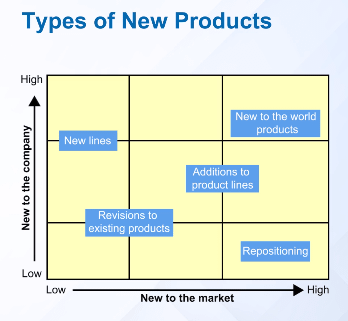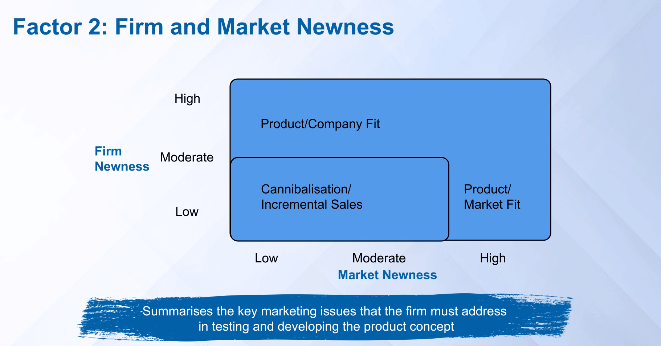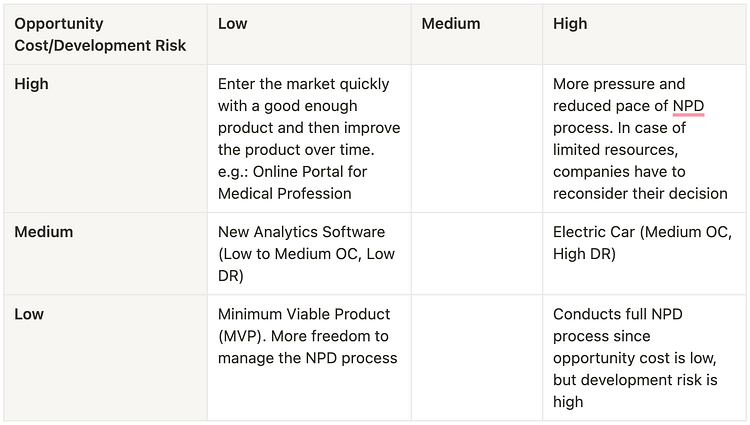In Short…
- Distinguish products, the commonly considered types of new products and the factors impacting their success and failure.
- The implications of the context of a new product development process or NPD process on its applications.
- How to make decisions about how fast or slow the NPD process should be in any given context.
- How during the NPD process, a company uses marketing research to obtain information from potential consumers to improve a product concept.
- The framework of opportunity cost and development risk.
- Understand what information is needed from potential consumers, the means to get the same, and when you can go to market with a minimum viable product or MVP, given the context of your NPD process.
- Causality, reasons for conducting experiments, and issues of validity in the experiments.
- A/B and A/A testing and growth hacking.
Type of New Product Variations
Levels of a Product:
- Core Product (e.g.: Security for a financial transaction)
- Tangible Product: the transformation of a core product into something customers can buy (e.g.: Physical VISA card)
- Augmented Product: Enhancement to the tangible product to make the product competitive (e.g.: warranty, customer service, loyalty points, etc)
New Product Variations:
- New to the world product
- New Category entry
- Addition to the product line
- Product Improvement
- Repositioning of the product
Non-new product variations:
- Expansion into a new geography
- New channels of distributions
- Packaging improvements
- Different resources or methods of manufacturing

Success and Failure of New Products
- Why Does Your New Product Development Process Fail?
- 10 Recent Product Design Failures And What We Can Learn From Them
Lean Startup Model: Build a product, Measure the customer’s response, Learn from the responses, and based on the learning, repeat or pivot.
So, products are most likely to fail if one or more of the following 10 statements are true (for our convenience we provided 10; surely, there are far more than 10):
- Inadequate -or even worse- biased market research
- Focusing on the wrong target group
- Ignoring customer needs and wants
- Inadequate education of the audience if the product/service is disruptive
- Performing poorly in terms of user experience
- Taking the product very early out of the market
- Having a bad pricing strategy
- Spending extremely high budgets in developing a product only to realize that it does not have a market fit
- Not finding the ideal timing to enter the market
- Pivoting in the wrong direction
Context for New Product Development
1. Why is the new product needed? – based on market research depending on the context. Marketing research should not be standardized for all products. Reasons for new products can be increasing the market share.
2. Market and company newness to the proposed product

High Firm newness and Low market newness: Product/Company fit becomes an issue. To tackle this, the firm has to measure the capability of its marketing assets, R&D capabilities, look to avoid cannibalism of its own existing products, measure the diversification risk
Low firm newness and High market newness: Product/Market fit becomes an issue. To tackle this, the firm has to check market size at different prices and the financial capital to first build and then maintain the market.
Low firm newness, Low market newness: It can lead to cannibalization of existing products of the company.
3. Opportunity cost and development risk to the new product
Real-Life Examples of Opportunity Cost
Opportunity cost: Risk: Losing a fast-moving window of opportunity in the market. It helps in deciding the pace of the new product development.
Development Risk: Risk: Launching a wrong product in the market. it helps in deciding the speed precision tradeoff in marketing research

Causality and Correlation
Static Group Comparison Design

Before-After-With Control Group Design

Internal Validity: To check if an independent variable has a cause-effect relationship with a dependent variable.

It allows researchers to rule out alternative explanations
External Validity: The extent to which the results of the experiment can be generalized.
Internal Validity is more focused compared to external validity
Growth Hacking
- Definitive guide to growth hacking
- Every company needs a growth manager
- Growth Hacking: Strategies & Tactics Learned Studying 77 Hyper-Growth Companies
- The rise of the growth product manager
- Traction vs. Growth
- Startup = growth
Growth hacking is a marketing strategy and mindset that focuses on rapidly experimenting with various tactics and techniques to achieve rapid and sustainable growth for a business or product. It often involves a combination of creativity, data analysis, and unconventional methods to acquire and retain customers, increase user engagement, and drive revenue growth.
Example: Dropbox
Dropbox, a cloud storage and file-sharing service, is often cited as one of the most successful growth hacking stories. In its early days, Dropbox faced stiff competition in the crowded cloud storage market. They needed a unique approach to stand out and acquire users quickly.
Dropbox employed several growth hacking strategies:
Referral Program: Dropbox introduced a referral program that encouraged users to refer friends in exchange for extra storage space. When a user referred someone, both the referrer and the referee received additional storage space. This incentivized users to spread the word about Dropbox to their friends and colleagues.
Virality through Sharing: Dropbox made it incredibly easy for users to share files and folders with others. When users shared files with non-Dropbox users, they were prompted to sign up for Dropbox, which helped drive user acquisition.
Publicity Stunts: Dropbox also used unconventional methods to generate buzz. One of their famous growth hacks was when they posted a video on Digg in 2008, claiming to show Steve Jobs, then Apple’s CEO, endorsing their product. This led to significant media coverage and increased sign-ups.
Integration with Other Apps: Dropbox integrated its service with various apps and platforms, making it more valuable to users. This approach expanded their user base by tapping into existing user networks of other popular apps.
Data-Driven Iteration: Dropbox closely monitored user behavior and the effectiveness of their growth tactics. They continually analyzed data to refine their strategies, focusing on what worked best for user acquisition and retention.
These growth hacking tactics helped Dropbox grow from 100,000 users to over 4 million users in just 15 months. It demonstrates how a combination of creative marketing strategies, viral mechanisms, and data-driven decision-making can drive rapid and sustained growth for a startup or a product.
A/A and A/B testing
- What is A/A testing
- A/B Testing Tutorial: From Beginner to Pro in a Blog Post
- A/B testing in product management
- A to Z of A/B Testing for Product Managers
- A/B Testing Statistics Made Simple
A/A testing and A/B testing are both methods used in the field of experimentation and optimization, primarily in digital marketing and product development. They involve comparing two or more variations of a webpage, app, or marketing campaign to determine which one performs better. However, there is a key difference between the two:
A/A Testing:
In A/A testing, you compare two identical or nearly identical versions of a webpage, app, or campaign to establish a baseline or control group. The primary purpose of A/A testing is not to determine a winner but to check the reliability of your testing process. It helps ensure that your testing tool, tracking mechanisms, and data collection processes are functioning correctly. Essentially, it’s a way to validate that your testing setup is free from biases or errors before conducting A/B tests with different variations.
A/B Testing:
A/B testing, also known as split testing, is where you compare two or more different variations of a webpage, app feature, or marketing campaign to identify which one performs better in terms of a specific goal, such as click-through rates, conversion rates, or revenue. A/B testing is the standard method for optimizing digital assets by making data-driven decisions. It allows you to understand which changes or variations resonate better with your audience and lead to improved outcomes.
Example:
Let’s say you’re the product manager for an e-commerce website, and you want to optimize the product page to increase the conversion rate (the percentage of visitors who make a purchase). Here’s how you might use A/A testing and A/B testing:
A/A Testing:
- You create two identical versions of the product page, with no differences between them.
- Half of your website visitors are randomly assigned to version A, and the other half to version A.
- You run this test for a significant period to collect data on user behavior and conversions.
- After analyzing the data, you should ideally find that there is no significant difference in conversion rates between the two groups. This validates that your testing setup is working correctly and that any differences observed in future A/B tests are likely due to actual variations, not errors in your testing process.
A/B Testing:
- Now that you’ve validated your testing process with A/A testing, you decide to make a change to the product page. You create two different variations: A and B.
- Variation A might have a blue “Buy Now” button, while variation B has a green “Buy Now” button.
- You randomly assign visitors to either variation A or B and collect data on conversion rates for each group.
- After running the A/B test for a set period, you analyze the data to determine which variation, A or B, has a statistically significant higher conversion rate.
- If variation B (with the green button) performs significantly better, you might decide to permanently implement this change on your website to boost conversions.
In this example, A/A testing ensures the reliability of your testing setup, while A/B testing helps you identify which specific changes to your product page can lead to higher conversion rates. Both testing methods are crucial for effective experimentation and optimization in digital marketing and product development.
What is a MVP?
The Ultimate List of MVP Examples [20+ Case Studies]
A MVP, or Minimum Viable Product, is a concept popularized by Eric Ries in his book “The Lean Startup.” It’s a strategy and development approach in which a product is created with the minimum set of features required to meet the needs of early adopters and gather essential feedback for further product development. The goal of an MVP is to quickly validate or invalidate your assumptions about a product’s value, usability, and market fit with minimal resources invested.
How to create an MVP:
Identify Your Core Value Proposition: Define the fundamental problem your product aims to solve and the key value it provides to users.
List Key Features: Identify the most essential features that are necessary to address the core problem and provide value to users. These should be the minimum set of features required for users to find your product useful.
Build a Minimal Version: Develop a basic version of your product that includes only these key features. Keep it simple and avoid unnecessary complexity.
Test with Early Adopters: Launch your MVP to a small group of early adopters or beta testers who are willing to use the product in its early, potentially imperfect form.
Gather Feedback: Collect feedback from users and closely monitor how they interact with your MVP. Pay attention to what they like, dislike, and any suggestions for improvement.
Iterate and Improve: Based on the feedback and data collected, make incremental improvements to your product. Continue testing and iterating until you achieve product-market fit and a satisfactory user experience.
Now, let’s discuss how an MVP changes with the product life cycle and provide a real-life example:
Product Life Cycle Stages and MVP:
Introduction: In the introduction stage, the MVP serves to test the initial product concept, validate market demand, and gather user feedback. It should focus on solving the core problem and confirming that there is interest in the product.
Growth: As the product gains traction and user adoption increases, you can expand the MVP by adding more features and functionality to cater to a broader audience. The goal is to retain existing users and attract new ones by addressing their evolving needs.
Maturity: In the maturity stage, the product is well-established, and competition may be high. Your MVP should evolve into a more feature-rich and polished product to maintain market share and user satisfaction.
Decline or Pivot: If the product starts to decline in popularity or if market conditions change significantly, you may need to pivot your MVP into a new direction or sunset it gracefully.
Example: Slack
Slack, a popular team collaboration and communication platform, began as an MVP that was created to address a specific problem. The initial MVP had a simple chat interface and file sharing capabilities. It was designed for small teams and startups to improve communication and collaboration.
As Slack gained early adopters and received feedback, the company iterated on its product. They added features like channels, integrations, and a more robust search functionality. Over time, Slack evolved from a basic chat app into a comprehensive team collaboration platform used by organizations of all sizes.
The key to Slack’s success was starting with a narrow MVP focused on solving a core problem and then expanding and refining the product based on user feedback and changing market dynamics. This iterative approach allowed Slack to grow from an MVP into a widely adopted and successful product.
Note: These are notes from the ISB Executive Education – Product Management program for my personal consumption.
In case you are looking for a Product Management course, I would highly recommend joining this cohort-based course.
PS: You can connect with me for review or referral discount (link for referral discount)



